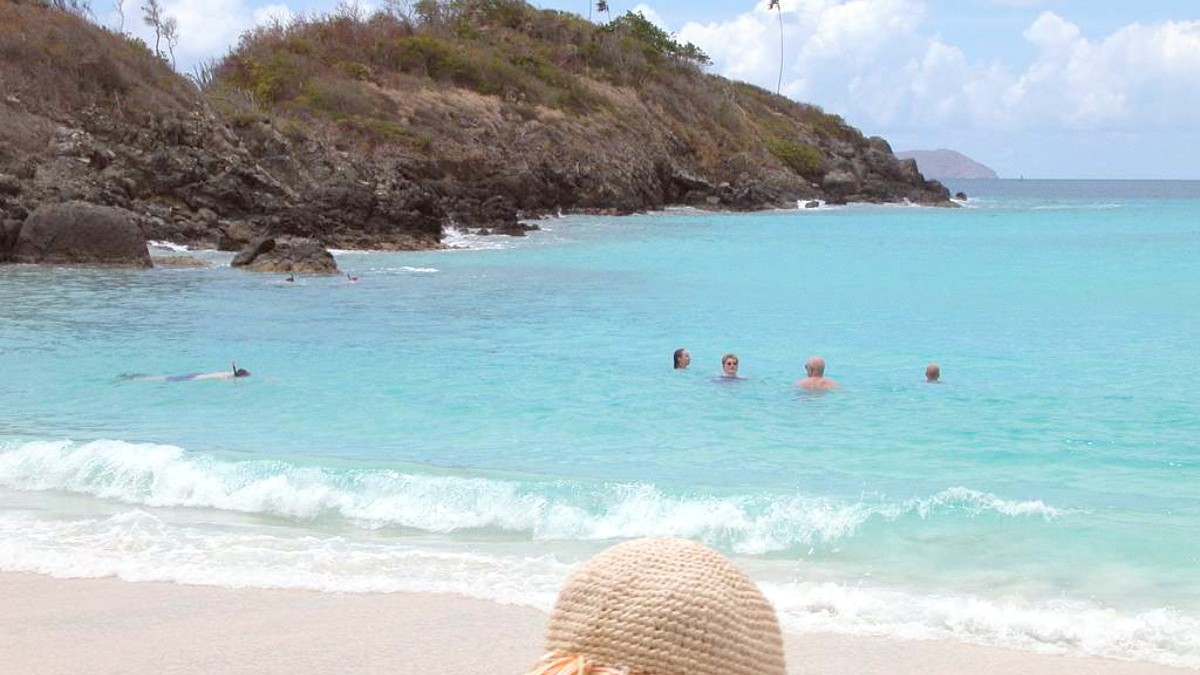
US Virgin Islands
St. John has a tropical savanna climate, with consistently warm temperatures and variations in rainfall. Average daily temperatures remain stable, typically ranging from 77°F (25°C) to 84°F (29°C) year-round. Evenings feel a few degrees cooler. This consistent warmth makes St. John a destination for visits any time of the year, with a comfortable climate for outdoor activities.
St. John has a drier season and a wetter season. The drier period generally extends from December to June. During these months, rainfall is minimal, and skies are typically clear. The wetter season, with higher humidity and brief, heavy showers, runs from July to November. Annual rainfall averages around 40-50 inches.
Each season on St. John presents different trade-offs in terms of crowds, prices, and weather conditions.
While showers in the wetter season can be intense, they often pass quickly. Extended periods of rain are uncommon outside of tropical storm activity. Humidity levels remain consistently high throughout the year, averaging 70-80 percent.
Mid-December to May
Ideal weather, less rain, lower humidity, consistent trade winds, calm seas. Lively around holidays.
Higher prices for flights, accommodation, tours. Popular attractions experience more visitors.
June, July, November, early December
Balance of good weather and fewer crowds. Prices for flights and lodging decrease. November can be excellent.
Possibility of tropical storms, especially late July. Occasional rain showers. Higher humidity.
August to October
Lowest prices for flights and accommodation. Fewest crowds, quiet and secluded experience.
Peak of hurricane season. Highest risk of storms. Businesses may reduce hours or close for renovations.
The official Atlantic hurricane season runs from June 1 to November 30. Peak activity typically occurs from mid-August to late October. While St. John is an U.S. Territory with robust emergency response systems, a direct hurricane strike can cause significant damage and travel disruption for weeks or months.
St. John does not experience extreme cold. While temperatures remain consistently warm, high humidity makes the heat feel more intense. Consistent easterly trade winds provide refreshing breezes, especially during the dry season.
They issue warnings and evacuation orders.
Flexible travel plans are advisable.
Prepare for potential disruptions.
Seek shade during the hottest parts of the day.
Heatstroke and sunburn are risks.
For St. John, these requirements vary by citizenship.
St. John is an U.S. Territory. U.S. Citizens traveling from the mainland United States or Puerto Rico do not need a passport for entry.
Non-U.S. Citizens must follow the same entry requirements as for entry into the United States mainland. This generally requires a valid passport.
No specific entry fees for the U.S. Virgin Islands beyond standard U.S. Entry procedures.
All travelers arriving by air clear U.S. Customs and Border Protection (CBP) upon arrival at Cyril E. King Airport (STT) on St. Thomas or at a pre-clearance facility.
No specific health-related entry requirements currently exist for general entry to St. John. Travelers should consult their healthcare provider for routine vaccinations recommended for travel to the Caribbean.
St. John can accommodate various budgets, but it is generally a more expensive Caribbean destination than some others.
Accommodation: Camping at Cinnamon Bay Campground ($35-$70) or a budget guesthouse ($80-$150). Meals: Self-catering (groceries from Starfish Market), street food, local food trucks. Transportation: Safari taxis ($10-$30). Activities: Free beaches, hiking trails. Example Day: Breakfast at campground, safari taxi to Cinnamon Bay ($7), hike, snorkel, picnic lunch, safari taxi back ($7), local dinner ($20), shared guesthouse ($37.50). Total: ~$71.50.
Accommodation: Mid-range hotel, comfortable condo, or smaller villa ($200-$400). Meals: Mix of self-catering, casual restaurants, nicer dinners ($60-$120). Transportation: Shared rental car (Jeep) ($50-$80 per person if split) or frequent safari taxis ($20-$50). Activities: Guided snorkeling tours, kayak/paddleboard rentals, boat excursions ($50-$100). Example Day: Hotel breakfast ($20), shared Jeep rental ($50), drive to Maho Bay, paddleboard ($30), casual lunch ($25), mid-range dinner ($50), drinks ($15). Total: ~$190.
High-end resort or private luxury villa ($500-$1500+).
Fine dining, private chef services ($150-$300+).
Private car service, luxury rentals, private boat charters ($100-$300+).
Private guided excursions, full-day boat charters, spa treatments ($100-$300+).
Luxury villa ($500), private chef breakfast ($50), private boat charter ($600), gourmet lunch ($40), spa ($150), fine dining dinner ($100), high-end drinks ($50). Total: ~$1490.
While St. John generally presents a safe environment, awareness and preparation are important.
No specific vaccinations for entry to St. John from the U.S. Mainland. The Centers for Disease Control and Prevention (CDC) recommends routine vaccinations are up to date.
St. John's tropical sun is strong. The UV index is high. Heatstroke and sunburn are risks.
Awareness of natural disaster risks is for preparation.